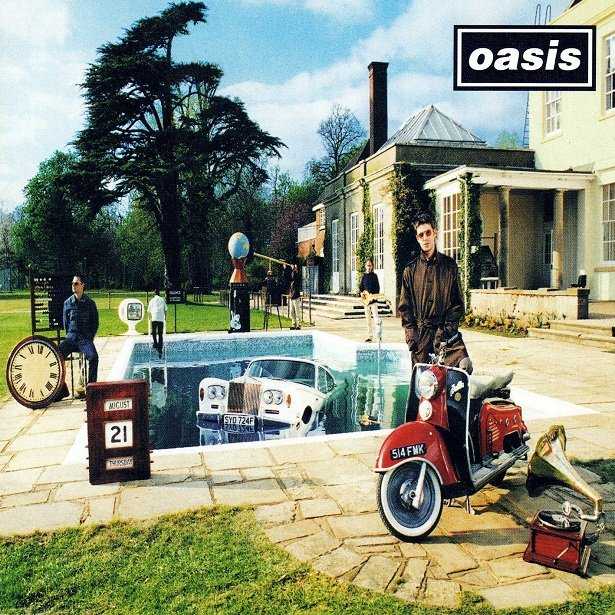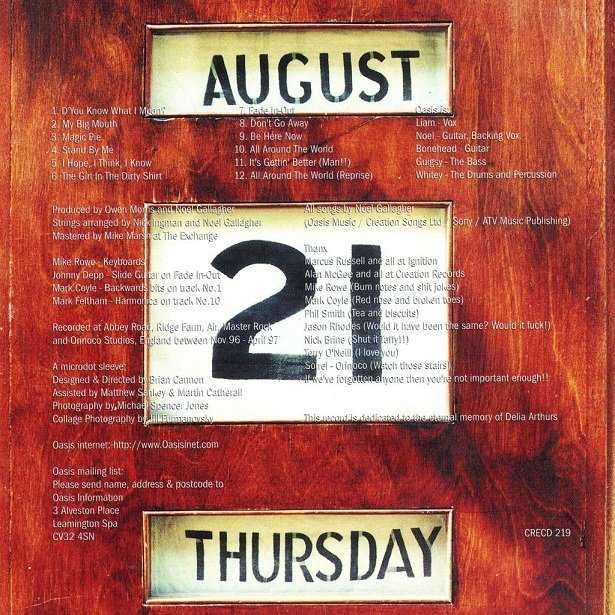
‘Be Here Now’. Crikey where to start?
Well if you like it, many would attest, you’re musically illiterate. A pint of lager and a packet of crisps please. A Saturday night can only be called a good Saturday night if it’s been rounded off at 4am with a healthy dose of fisticuffs and a taxi home in the back of a police van. You’re Mike Skinner‘s ‘The Irony Of It All‘ beer-swilling caricature in glorious reality. “Good clean grief you must believe and I ain’t no thief”.
You’re too ignorant for, and frankly don’t deserve, the nuances and painstaking effort which goes into a truly great rock record – all that went into ‘OK Computer‘, as a very pertinent example, since it was released just a few months before ‘Be Here Now‘ finally slaked the queues which were stretching out for miles from record shops on sun-scorched high streets that summer two decades ago. After seven days, well over a million people were already coming to terms with the UK’s biggest pop phenomenon since The Beatles.
Let’s get it right though, ‘Be Here Now’ is too long. Almost comically self-indulgent, overblown, the sound of a band making snowmen in the studio, hoovering up the early profits of a monster of a previous album, not giving any particular hoot to the expectation, hype and column inches it had generated and which were in a feverish mania outside the otherwise peaceful surroundings of Surrey farmland during the early months of 1997.
Liam Gallagher doesn’t need to sing “It’s getting better man” about 500 times. ‘All Around The World‘ doesn’t need to “na, na, na” on for nearly ten minutes. It doesn’t need scores of Noel Gallagher guitar layers weighing down pretty much every track. There doesn’t need to be a reprise. Above all, at that time there probably didn’t need to be a new Oasis album at all.
It had been an extraordinary rise. Barely a year on from signing their first record deal, Oasis had the (at the time) fastest selling debut album in history. ‘Definitely Maybe‘ is a genuine classic, it remains their true, authentic sound before they would go on to be buried underneath a lifetime’s worth of drama, notoriety and seemingly constant upheaval.
Before another twelve months had been navigated ‘Some Might Say‘ had topped the charts and its eventual parent album, ‘(What’s The Story) Morning Glory?‘, shortly after arrived to a considered response from critics but an insatiable response from fans. A dramatic lurch from the nature of its predecessor, punk in almost every form, the acoustic guitars and classic songwriting heroes of Noel Gallagher were now at the fore, delivering a strange mix of radio friendly, stadium ready anthems which still somehow contained that unique, acerbic, irresistible Oasis formula which to this day is hard to adequately articulate.
It was a rise which by August 1996, another ridiculously brief interval of time, had gone global and truly Fab in the UK. Those two nights at Knebworth in front of record crowds should’ve been the point to apply the breaks, to take a breather and some time to consider the next move. Yet it was never in the band’s nature. Instead, the party continued and those at the wheel began to lose control. Days after Knebworth, Liam was heckling an under-rehearsed Noel during MTV Unplugged, doing an about-turn on a US tour at the airport. Noel, not for the first time and not for the last, going in the same direction with every intention of permanence soon after.
And yet there they were, in October 1996, recording a new album at Abbey Road. If being promptly kicked out of such a hallowed studio was a hint from the musical gods, it wasn’t heeded. As Noel Gallagher himself later reflected: “There was more…recreational behaviour. And before you know it, the manager’s booked you a tour and you’re back out on the road again. I remember going halfway round the world and thinking, ‘hang on a minute, I was supposed to be leaving. How did this happen?’”.
It wasn’t just in the Oasis bubble where things were moving fast. The hedonism and superficiality of the mid-nineties had become tiresome for a tabloid press which first lit the Britpop touchpaper. For critics in 1997, the aforementioned ‘OK Computer’ would be their saving grace from trivial chart battles, lad culture and Country Houses. For the record buying public, The Verve brought similar respite. The introspection and sombre nature of Richard Ashcroft stood in stark contrast to the triumphalism of his close friends, providing a hangover cure on ‘Bittersweet Symphony‘, the ‘Urban Hymns‘ LP and follow-up single ‘The Drugs Don’t Work‘ later offering more tranquillity and change of mood in the face of the Gallagher brothers’ continuing racket.
There is then, seemingly an awful lot to lament about Oasis’ third studio album. So why, on the eve of an extensive reissue as the final part of the Chasing The Sun series, does it still hold such an emotional grip on so many of those millions who first snapped it up nearly twenty years ago, and indeed to those who have discovered it since?
Simply because, the magic which made Oasis heroes to a generation is still there, it’s just having to fight a lot harder for attention. Like a ray of early morning sunshine breaking through the oak doors of an ancient church, that authenticity, that wizardry which had carried the band to worldwide stardom does eventually makes itself known against all the odds. A lot of those fans would declare ‘Be Here Now’ their favourite album. Are they musically illiterate? Of course not, they’ve just been digging a little deeper for the buried treasure.
Where is the treasure to be found? At the feet of producer Owen Morris, who got the Oasis sound like no-one else, there in bucket-loads on the riotous ‘My Big Mouth‘ and opener ‘D’You Know What I Mean‘. The lead single is the most obvious misnomer to the accepted narrative; expanded out to breaking point and yet working perfectly at its length with the feedback, reverb and who knows what else that’s thrown in, qualities only emphasised by the recent ‘2016 NG Rethink.

‘I Hope, I Think, I Know‘ and the title-track also survive. A much over-looked point is that Noel Gallagher was rarely a songwriter happy to say it all in two-and-a-half-minutes; ‘Definitely Maybe’ and ‘…Morning Glory’ packed themselves too with intros and outros that go on as long as they see fit, the aforementioned pair doing the same on ‘Be Here Now’ with a pleasingly simple pop nuance that would’ve made them equally as strong album tracks on those which went before.
In amongst all the bluster, ‘Don’t Go Away‘ remains one of Noel’s most personal lyrics. A plea to a brittle loved one, a chink in the armour out of nowhere, a show of insecurity and fragility just when he wanted to believe he was invincible. ‘Fade In-Out‘ is dramatic, quite literally screaming to be heard above the chaos and another track which justifies the duration of its stay. And as always with Oasis, the hidden treasures are the b-sides; ‘Flashbax‘, ‘(I Got) The Fever‘, ‘Stay Young‘, ‘Going Nowhere‘, ‘Angel Child‘. All this and an album 70 minutes in duration – at least pocket money went along way back then.
The treasure is there on Liam Gallagher’s vocals: still indomitable, still unique and still delivering every track with a passion that cuts right through to the heart. The most important cog in the Oasis machinery hits a peak on ‘Be Here Now’. With cynicism simply a word that didn’t exist in his universe, he was in the studio because that’s what he knew, what he did, what had brought him fame and fortune. This innocence and care-free abandon, this youthfulness even, had by the same token defined his band from the start. Like most else on the record, these are abstruse virtues taken to their logical conclusion, never quite rediscovered in the 21st century, Oasis never quite the same for it.
Treasured is the tour. The stadiums which would underpin the Oasis legacy might be missing, but in their place are gigs now clutched close to fans’ chests. In Manchester, the G-Mex would host the ultimate local rags-to-riches story, and in turn add a sense of narrative to ‘Be Here Now’. The ten minute “na na nas” of ‘All Around The World’ are suddenly joyous, a Stanley Unwin gobbledegook tale of glory days. The 500 strong “It’s getting better man” refrain is delivered with an ever increasing menace. The rock and roll circus went on, creating legend in Den Bosch, the Budokan, Aberdeen, Dublin before blowing out over a plate of scones high above the Pacific Ocean. No longer The Beatles of their era, Oasis were well on their way to being the Stones of their era; losing their immunity in the studio whilst simultaneously becoming one of the truly great live bands.
‘Be Here Now’ shouldn’t have worked, and with fate in the hands of a sensible, rationally functioning band, wouldn’t even exist. The faceless ‘many’ will equally attest that it doesn’t work, and shouldn’t exist. Yet for so many others it’s the final statement from the incarnation of a band they love more than any other. It stands in 2016, an age when rock and roll exists on the sidelines, as perhaps the most appropriately named album in history, an album on which the ethos of the group, their era and their generation – however flawed – are captured forever.
Far more than the sum of its parts, ‘Be Here Now’ too is about memories. Your memories. The memory of being young. Of your favourite band being omnipresent in your life. Of sharing the excitement of release day outside a record shop with family, or friends, or complete strangers. The journey home which lasted ten minutes but on this occasion felt like hours. Of pressing play and embarking on that bloody long odyssey for the very first time. Of that summer, when Britpop was about to be shown up for the sham that it was, when Noel Gallagher was shaking hands with the new Prime Minister, but when Oasis were, like all the great bands, still a gang. A gang which had – without an ounce of compromise – become the biggest and, for millions, the best.
For those who adore it, to question their character, their credentials as music fans, is to miss the point entirely. Just like ‘Definitely Maybe’ always had, with the passing of time today ‘Be Here Now’s greatest strength is its escapism – a time capsule packed with cherished moments that are all your own, and need no-one else’s justification.
Thursday, August 21st 1997 will always be right here, right now.




Best album they did.. PURE IN YER FACE HAVE IT ROCK N ROLL. Absolute agression.
Cracking review. Hit the nail on he head about 26 times…
Great review, and pretty much sums up why Be Here Now is, and always will be, may favourite album of all time. The best there was, the best there is, the best there ever will be…
Fucking bang on review. Excellently written.